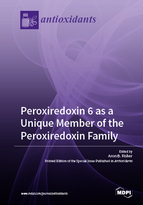Peroxiredoxin 6 as a Unique Member of the Peroxiredoxin Family
A special issue of Antioxidants (ISSN 2076-3921). This special issue belongs to the section "Antioxidant Enzyme Systems".
Deadline for manuscript submissions: closed (31 October 2018) | Viewed by 48021
Special Issue Editor
Interests: oxidant stress; anti-oxidants; reactive oxygen species; lipid peroxidation; GSH peroxidase; phospholipase A2; cell signalling; endothelial shear stress; mechanotransduction; lung surfactant; acute lung injury
Special Issue Information
Dear Colleagues,
Peroxiredoxin 6 is truly a unique member of the peroxiredoxin family. While it is similar to other peroxiredoxins in its peroxidase activity towards small peroxides, such as H2O2, it exhibits several important characteristics that distinguish it from other peroxiredoxins. These characteristics of Peroxiredoxin 6 include: a catalytic mechanism for peroxidase activity that depends on a single conserved Cys in contrast to the 2-Cys mechanisms for most other peroxiredoxins; the use of GSH as the primary physiological reductant for peroxidase activity in contrast to the thioredoxin that is the primary reductant for other peroxiredoxins; the ability to bind phospholipids; the activity to reduce phospholipid hydroperoxides to the corresponding alcohol, i.e., phospholipid hydroperoxide glutathione peroxidase activity; the activity to hydrolyze the sn-2 fatty acyl bond of phospholipids, i.e.,phospholipase A2 activity (PLA2); and activity to transfer a fatty acyl CoA into the sn-2 position of lysophosphatidylcholine, i.e., lysoPC acyl transferase activity. The binding of phospholipids and the associated lipid-related enzymatic activities of Peroxiredoxin 6 are not expressed by other members of the peroxiredoxin family. Thus, Prdx6 is a unique multifunctional protein.
Peroxiredoxin 6 has been demonstrated to play specific and important roles in normal physiology. Well-documented roles include: Anti-oxidant defense and the repair of peroxidized cell membranes, the turnover of lung surfactant phospholipids,and cellular signaling such as in mechanotransduction and the activation of NADPH oxidase. Although less well documented, Peroxiredoxin 6 has been postulated to be important in the pathophysiology of acute lung injury and inflammation, cancer and carcinogenesis, various chronic diseases of the CNS, cataracts and retinal disease, type 2 diabetes, and male infertility, among others. Thus, there is important depth and breadth to the study of Prdx6.
While Peroxiredoxin 6 has been included in published forums dealing with peroxiredoxins in general, there has not been, to date, a forum dealing specifically with this protein. I believe that the time is ripe. This Special Issue welcomes submission of reviews or original research addressing any aspect of Peroxiredoxin 6 structure/function relationships and the physiological/pathophysiological roles of its unique enzymatic activities.
Dr. Aron B. FisherGuest Editor
Manuscript Submission Information
Manuscripts should be submitted online at www.mdpi.com by registering and logging in to this website. Once you are registered, click here to go to the submission form. Manuscripts can be submitted until the deadline. All submissions that pass pre-check are peer-reviewed. Accepted papers will be published continuously in the journal (as soon as accepted) and will be listed together on the special issue website. Research articles, review articles as well as short communications are invited. For planned papers, a title and short abstract (about 100 words) can be sent to the Editorial Office for announcement on this website.
Submitted manuscripts should not have been published previously, nor be under consideration for publication elsewhere (except conference proceedings papers). All manuscripts are thoroughly refereed through a single-blind peer-review process. A guide for authors and other relevant information for submission of manuscripts is available on the Instructions for Authors page. Antioxidants is an international peer-reviewed open access monthly journal published by MDPI.
Please visit the Instructions for Authors page before submitting a manuscript. The Article Processing Charge (APC) for publication in this open access journal is 2900 CHF (Swiss Francs). Submitted papers should be well formatted and use good English. Authors may use MDPI's English editing service prior to publication or during author revisions.
Keywords
- Peroxiredoxin
- GSH peroxidase
- Phospholipase A2
- Thiol reactions
- SDH catalytic triad
- Cellular signaling
- Oxidant stress
- Phospholipid turnover
- Inflammation
- Carcinogenesis
Related Special Issues
- The Role of Peroxiredoxins in Cancer in Antioxidants (5 articles)
- Peroxiredoxin in Antioxidants (20 articles)







